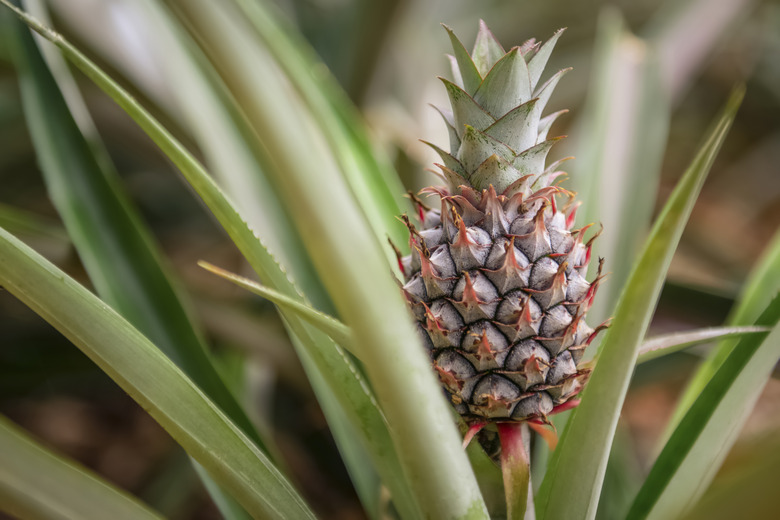How To Grow Pineapples
Learning how to grow pineapples lets you enjoy a touch of the tropics at home. Pineapples (Ananas comosus) are tropical plants, belonging to the bromeliad family (Bromeliaceae). These fruiting perennials are perennials in U.S. Department of Agriculture plant hardiness zones 10 through 12 but are sometimes grown as houseplants. Pineapples do well when grown in container gardens and are easier to grow indoors where they are protected from insect pests and cool weather. Most grow these plants for their spiky foliage and tropical feel rather than for fruit as it can take two to three years for the plant to produce fruit.
How To Grow Pineapples
1. Choose a Pineapple Plant
Purchase a pineapple plant at your local nursery. If you have trouble finding a suitable young plant, simply purchase a fresh pineapple with plenty of green leaves at the grocery store. Cut the crown off the pineapple as close to the leaves as possible. Remove all of the fruit from the crown until only the leaves remain. Cut off thin slices from the bottom of the crown until you see a row of brown dots, which are young roots. Let the pineapple top-dry for a day or two before planting.
2. Select the Planting Location
Choose a suitable planting location for your pineapple plant or top. Pineapples need sandy or loamy soil that drains well and prefer their soil slightly acidic. If you are planting your pineapple in a pot, choose a 3- to 7-gallon container and use cactus soil. Pineapples also like full sun but will do well in very light shade. For optimal growth and fastest fruiting, choose a location where the temperature will stay between 68 and 80 degrees Fahrenheit.
3. Plant the Pineapple
Dig a hole as deep as the root ball and three times as wide as the container to plant a nursery specimen. Loosening this much soil will make it easy for the pineapple's roots to spread. If you are planting a pineapple crown, simply plant it about an inch deep, removing any leaves that would be covered by the soil. Backfill your planting hole and water the plant thoroughly.
4. Water Your Pineapple Plant
Water your pineapple plant no more than once a week if rainfall hasn't done the job for you. If you're starting a new plant from a pineapple top, water every few days until the roots begin to grow. Pineapples like moist soil but don't tolerate flooding or wet feet. Always check the soil moisture before assuming your plant needs a drink. When in doubt, skip the water.
5. Fertilize the Plant
Fertilize your plant with a slow-release fertilizer or a foliar spray every 8 to 10 weeks when you start to see new leaves. Pineapples have small root systems, so they absorb most nutrients through their leaves. You can use a citrus fertilizer, or choose a fertilizer with an NPK ratio between 6-6-6 and 10-10-10 and which also includes 5 to 6 percent magnesium. If your plant hasn't flowered in 16 months, take a break from fertilizing over the winter to induce flowering and subsequent fruiting.
Pineapple plants are susceptible to leaf burn. Always follow foliar fertilizer instructions thoroughly to prevent plant damage.
6. Check for Pests
Inspect your plants frequently for mealy bugs and scale insects. Pests aren't usually a problem indoors, but they can plague garden-grown pineapples. Look for ants, as well, as they sometimes herd mealybugs onto plants to farm them. A shot of water from the garden hose is enough to dislodge these insect pests. If the pests persist, treat the plant with insecticidal soap on a cloudy day. Chemical insecticides can be applied as a last resort, but do so carefully if you intend to eat the fruit your plant produces.
7. Stake Your Pineapple
Stake your pineapple if the growing fruit becomes top heavy. If there is a fear that possums, raccoons or other critters may dine on your pineapple before you can harvest, place a paper bag over the growing fruit to keep animals at bay.
8. Force It to Flower
Force a mature pineapple plant to flower by placing a few ripe apples next to it and loosely sealing it in a clear plastic bag for a week. Keep the plant out of direct sunlight while the bag is on it. When the week is up, remove the bag and the apples. You can expect a flower in about six weeks.
9. Harvest Your Pineapple
Harvest your pineapple when the fruit shell changes from light green to a greenish yellow. Finish ripening the fruit at room temperature on your counter. The pineapple is fully ripened when it turns yellow. Pineapple plants will decline in health after producing fruit. Don't try to save the plant. Instead, concentrate on the small pups growing at its base as these young plants are the next generation. Plant and care for them as you did your initial plant.
